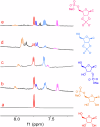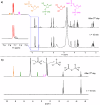Phosphorylation of nucleosides by P-N bond species generated from prebiotic reduced phosphorus sources
- PMID: 40523969
- PMCID: PMC12170892
- DOI: 10.1038/s42004-025-01577-0
Phosphorylation of nucleosides by P-N bond species generated from prebiotic reduced phosphorus sources
Abstract
P-N species e.g., amidophosphates readily phosphorylate organics, thereby overcoming the so-called 'Phosphate Problem'. However, the formation of amidophosphates by plausible early Earth geochemical pathways is limited. We herein show that ammonolysis of the prebiotically plausible dimer of phosphite, pyrophosphite, readily affords amidophosphite, the monomeric P-N derivative of phosphite. Amidophosphite then undergoes spontaneous oxidation to form monoamidophosphate (MAP) and diamidophosphate (DAP) at room temperature (yields of the inorganic P-N species up to 48%). Oxidation of amidophosphite is promoted by O2, H2O2, ClO⁻ and by UV light irradiation (365 nm). Both amidophosphite and MAP and the crude reaction mixture react with nucleosides to form nucleotides with both phosphate and H-phosphonate (yields up to 65%) at 80 °C in the presence of urea, showing that monoamidated phosphorus compounds also willingly promote prebiotic reactions. This observation expands the range of P-N phosphorylating agents that can play a role in the chemical evolution of prebiotic molecules on the early Earth.
© 2025. The Author(s).
Conflict of interest statement
Competing interests: The authors declare no competing interests.
Figures









Similar articles
-
Thermodynamic Constraints on the Citric Acid Cycle and Related Reactions in Ocean World Interiors.ACS Earth Space Chem. 2025 May 22;9(6):1392-1412. doi: 10.1021/acsearthspacechem.4c00371. eCollection 2025 Jun 19. ACS Earth Space Chem. 2025. PMID: 40556939 Free PMC article.
-
Organic Synthesis Away from Equilibrium: Contrathermodynamic Transformations Enabled by Excited-State Electron Transfer.Acc Chem Res. 2024 Jul 2;57(13):1827-1838. doi: 10.1021/acs.accounts.4c00227. Epub 2024 Jun 21. Acc Chem Res. 2024. PMID: 38905487 Free PMC article.
-
Signs and symptoms to determine if a patient presenting in primary care or hospital outpatient settings has COVID-19.Cochrane Database Syst Rev. 2022 May 20;5(5):CD013665. doi: 10.1002/14651858.CD013665.pub3. Cochrane Database Syst Rev. 2022. PMID: 35593186 Free PMC article.
-
Comparison of Two Modern Survival Prediction Tools, SORG-MLA and METSSS, in Patients With Symptomatic Long-bone Metastases Who Underwent Local Treatment With Surgery Followed by Radiotherapy and With Radiotherapy Alone.Clin Orthop Relat Res. 2024 Dec 1;482(12):2193-2208. doi: 10.1097/CORR.0000000000003185. Epub 2024 Jul 23. Clin Orthop Relat Res. 2024. PMID: 39051924
-
Fundamental Role of N-O Bond-Containing Compounds in Prebiotic Synthesis.JACS Au. 2025 Jun 10;5(6):2420-2442. doi: 10.1021/jacsau.5c00334. eCollection 2025 Jun 23. JACS Au. 2025. PMID: 40575316 Free PMC article. Review.
References
-
- Gulick, A. Phosphorus as a factor in the origin of life. Am. Sci.43, 479–489 (1955).
-
- Pasek, M. A. A role for phosphorus redox in emerging and modern biochemistry. Curr. Opin. Chem. Biol.49, 53–58 (2019). - PubMed
-
- Gull, M. Prebiotic phosphorylation reactions on the early Earth. Challenges5, 193–212 (2014).
-
- Krishnamurthy, R., Guntha, S. & Eschenmoser, A. Regioselective alpha phosphorylation of aldoses in aqueous solution. Angew. Chem. Int. Ed.39, 2281–2285 (2000). - PubMed
Grants and funding
LinkOut - more resources
Full Text Sources

